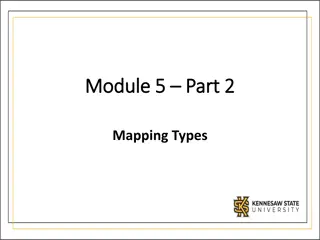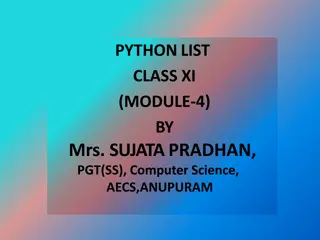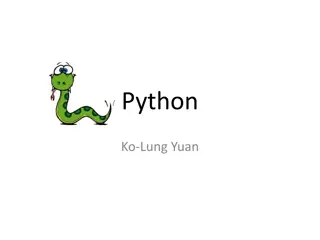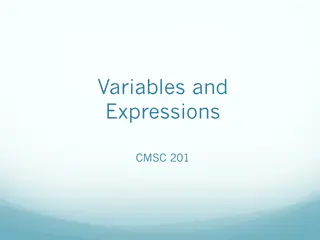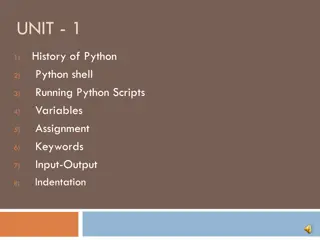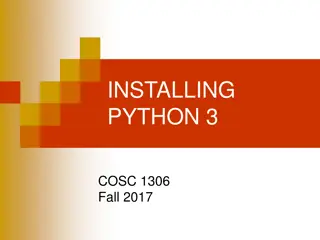Understanding Basic Elements of Python Programs
Explore the fundamental aspects of Python programming such as literals, assignments, datatype conversion, identifiers, and expressions. Learn how to work with variables, values, and simple Python commands effectively.
Download Presentation

Please find below an Image/Link to download the presentation.
The content on the website is provided AS IS for your information and personal use only. It may not be sold, licensed, or shared on other websites without obtaining consent from the author. Download presentation by click this link. If you encounter any issues during the download, it is possible that the publisher has removed the file from their server.
E N D
Presentation Transcript
15-110: Principles of Computing Basic Elements of Python Programs Lecture 2, September 04, 2018 Mohammad Hammoud Carnegie Mellon University in Qatar
Today Last Session: Motivation Introduction to Hardware Basics & Programming Languages Writing Simple Python Commands Today s Session: Basic Elements of Python Programs: Literals, Assignments, Datatype Conversion, Identifiers, and Expressions Announcement: We will practice on the Python basic elements on Thursday, September 06, 2018 during the recitation
Literals In the following example, the parameter values passed to the print function are all technically called literals More precisely, Hello and Programming is fun! are called textual literals, while 3 and 2.3 are called numeric literals >>> print("Hello") Hello >>> print("Programming is fun!") Programming is fun! >>> print(3) 3 >>> print(2.3) 2.3
Simple Assignment Statements A literal is used to indicate a specific value, which can be assigned to a variable >>> x = 2 >>> print(x) 2 >>> x = 2.3 >>> print(x) 2.3 x is a variable and 2 is its value
Simple Assignment Statements A literal is used to indicate a specific value, which can be assigned to a variable >>> x = 2 >>> print(x) 2 >>> x = 2.3 >>> print(x) 2.3 x is a variable and 2 is its value x can be assigned different values; hence, it is called a variable
Simple Assignment Statements: Box View A simple way to view the effect of an assignment is to assume that when a variable changes, its old value is replaced x = 2.3 >>> x = 2 >>> print(x) 2 >>> x = 2.3 >>> print(x) 2.3 Before After x x 2 2.3
Simple Assignment Statements: Actual View Python assignment statements are actually slightly different from the variable as a box model In Python, values may end up anywhere in memory, and variables are used to refer to them x = 2.3 >>> x = 2 >>> print(x) 2 >>> x = 2.3 >>> print(x) 2.3 After Before What will happen to value 2? 2 x x 2 2.3
Garbage Collection Interestingly, as a Python programmer you do not have to worry about computer memory getting filled up with old values when new values are assigned to variables After Memory location will be automatically reclaimed by the garbage collector Python will automatically clear old values out of memory in a process known as garbage collection X 2 x 2.3
Assigning Input So far, we have been using values specified by programmers and printed or assigned to variables How can we let users (not programmers) input values? In Python, input is accomplished via an assignment statement combined with a built-in function called input <variable> = input(<prompt>) When Python encounters a call to input, it prints <prompt> (which is a string literal) then pauses and waits for the user to type some text and press the <Enter> key
Assigning Input Here is a sample interaction with the Python interpreter: >>> name = input("Enter your name: ") Enter your name: Mohammad Hammoud >>> name 'Mohammad Hammoud' >>> Notice that whatever the user types is then stored as a string What happens if the user inputs a number?
Assigning Input Here is a sample interaction with the Python interpreter: >>> number = input("Enter a number: ") Enter a number: 3 >>> number '3' >>> Still a string! How can we force an input number to be stored as a number and not as a string? We can use the built-in evalfunction, which can be wrapped around the input function
Assigning Input Here is a sample interaction with the Python interpreter: >>> number = eval(input("Enter a number: ")) Enter a number: 3 >>> number 3 >>> Now an int (no single quotes)!
Assigning Input Here is a sample interaction with the Python interpreter: >>> number = eval(input("Enter a number: ")) Enter a number: 3.7 >>> number 3.7 >>> And now a float (no single quotes)!
Assigning Input Here is another sample interaction with the Python interpreter: >>> number = eval(input("Enter an equation: ")) Enter an equation: 3 + 2 >>> number 5 >>> The eval function will evaluate this formula and return a value, which is then assigned to the variable number
Datatype Conversion Besides, we can convert the string output of the input function into an integer or a float using the built-in int and floatfunctions >>> number = int(input("Enter a number: ")) Enter a number: 3 >>> number 3 >>> An integer (no single quotes)!
Datatype Conversion Besides, we can convert the string output of the input function into an integer or a float using the built-in int and float functions >>> number = float(input("Enter a number: ")) Enter a number: 3.7 >>> number 3.7 >>> A float (no single quotes)!
Datatype Conversion As a matter of fact, we can do various kinds of conversions between strings, integers and floats using the built-in int, float, and str functions >>> x = 10 >>> float(x) 10.0 >>> str(x) '10' >>> >>> y = "20" >>> float(y) 20.0 >>> int(y) 20 >>> >>> z = 30.0 >>> int(z) 30 >>> str(z) '30.0' >>> integer float integer string string float string integer float integer float string
Simultaneous Assignment Python allows us also to assign multiple values to multiple variables all at the same time >>> x, y = 2, 3 >>> x 2 >>> y 3 >>> This form of assignment might seem strange at first, but it can prove remarkably useful (e.g., for swapping values)
Simultaneous Assignment Suppose you have two variables x and y, and you want to swap their values (i.e., you want the value stored in x to be in y and vice versa) >>> x = 2 >>> y = 3 >>> x = y >>> y = x >>> x 3 >>> y 3 X CANNOT be done with two simple assignments
Simultaneous Assignment Suppose you have two variables x and y, and you want to swap their values (i.e., you want the value stored in x to be in y and vice versa) >>> x = 2 >>> y = 3 >>> temp = x >>> x = y >>> y = temp >>> x 3 >>> y 2 >>> Thus far, we have been using different names for variables. These names are technically called identifiers CAN be done with three simple assignments, but more efficiently with simultaneous assignment
Identifiers Python has some rules about how identifiers can be formed Every identifier must begin with a letter or underscore, which may be followed by any sequence of letters, digits, or underscores >>> x1 = 10 >>> x2 = 20 >>> y_effect = 1.5 >>> celsius = 32 >>> 2celsius File "<stdin>", line 1 2celsius ^ SyntaxError: invalid syntax
Identifiers Python has some rules about how identifiers can be formed Identifiers are case-sensitive >>> x = 10 >>> X = 5.7 >>> print(x) 10 >>> print(X) 5.7
Identifiers Python has some rules about how identifiers can be formed Some identifiers are part of Python itself (they are called reserved words or keywords) and cannot be used by programmers as ordinary identifiers False class finally is return None True continue def for from lambda nonlocal try while and as assert del elif else global if import not or pass with yield break except in raise Python Keywords
Identifiers Python has some rules about how identifiers can be formed Some identifiers are part of Python itself (they are called reserved words or keywords) and cannot be used by programmers as ordinary identifiers >>> for = 4 File "<stdin>", line 1 for = 4 ^ SyntaxError: invalid syntax An example
Expressions You can produce new data (numeric or text) values in your program using expressions >>> x = 2 + 3 >>> print(x) 5 >>> print(5 * 7) 35 >>> print("5" + "7") 57 This is an expression that uses the additionoperator
Expressions You can produce new data (numeric or text) values in your program using expressions >>> x = 2 + 3 >>> print(x) 5 >>> print(5 * 7) 35 >>> print("5" + "7") 57 This is an expression that uses the additionoperator This is another expression that uses the multiplicationoperator
Expressions You can produce new data (numeric or text) values in your program using expressions >>> x = 2 + 3 >>> print(x) 5 >>> print(5 * 7) 35 >>> print("5" + "7") 57 This is an expression that uses the additionoperator This is another expression that uses the multiplicationoperator This is yet another expression that uses the addition operator butto concatenate (or glue) strings together
Expressions You can produce new data (numeric or text) values in your program using expressions >>> x = 6 >>> y = 2 >>> print(x - y) 4 >>> print(x/y) 3.0 >>> print(x//y) 3 >>> print(x*y) 12 >>> print(x**y) 36 >>> print(x%y) 0 >>> print(abs(-x)) 6 Another example Yet another example
Expressions: Summary of Operators Operator Operation + Addition - Subtraction * Multiplication / Float Division ** Exponentiation abs() Absolute Value // Integer Division % Remainder Python Built-In Numeric Operations
Explicit and Implicit Data Type Conversion Data conversion can happen in two ways in Python 1. Explicit Data Conversion (we saw this earlier with the int, float, and str built-in functions) 2. Implicit Data Conversion Takes place automatically during run time between ONLY numeric values E.g., Adding a float and an integer will automatically result in a float value E.g., Adding a string and an integer (or a float) will result in an error since string is not numeric Applies type promotion to avoid loss of information Conversion goes from integer to float (e.g., upon adding a float and an integer) and not vice versa so as the fractional part of the float is not lost
Implicit Data Type Conversion: Examples >>> print(2 + 3.4) 5.4 >>> print( 2 + 3) 5 >>> print(9/5 * 27 + 32) 80.6 >>> print(9//5 * 27 + 32) 59 >>> print(5.9 + 4.2) 10.100000000000001 >>> The result of an expression that involves a float number alongside (an) integer number(s) is a float number
Implicit Data Type Conversion: Examples >>> print(2 + 3.4) 5.4 >>> print( 2 + 3) 5 >>> print(9/5 * 27 + 32) 80.6 >>> print(9//5 * 27 + 32) 59 >>> print(5.9 + 4.2) 10.100000000000001 >>> The result of an expression that involves a float number alongside (an) integer number(s) is a float number The result of an expression that involves values of the same data type will not result in any conversion
Modules One problem with entering code interactively into a Python shell is that the definitions are lost when we quit the shell If we want to use these definitions again, we have to type them all over again! To this end, programs are usually created by typing definitions into a separate file called a module or script This file is saved on disk so that it can be used over and over again A Python module file is just a text file with a .py extension, which can be created using any program for editing text (e.g., notepad or vim)
Programming Environments and IDLE A special type of software known as a programming environment simplifies the process of creating modules/programs A programming environment helps programmers write programs and includes features such as automatic indenting, color highlighting, and interactive development The standard Python distribution includes a programming environment called IDLE that you can use for working on the programs of this course
Summary Programs are composed of statements that are built from identifiers and expressions Identifiers are names They begin with an underscore or letter which can be followed by a combination of letter, digit, and/or underscore characters They are case sensitive Expressions are the fragments of a program that produce data They can be composed of literals, variables, and operators
Summary A literal is a representation of a specific value (e.g., 3 is a literal representing the number three) A variable is an identifier that stores a value, which can change (hence, the name variable) Operators are used to form and combine expressions into more complex expressions (e.g., the expression x + 3 * y combines two expressions together using the + and * operators)
Summary In Python, assignment of a value to a variable is done using the equal sign (i.e., =) Using assignments, programs can get inputs from users and manipulate them internally Python allows simultaneous assignments, which are useful for swapping values of variables Datatype conversion involves converting implicitly and explicitly between various datatypes, including integer, float, and string
Next Lecture Functions- Part I














